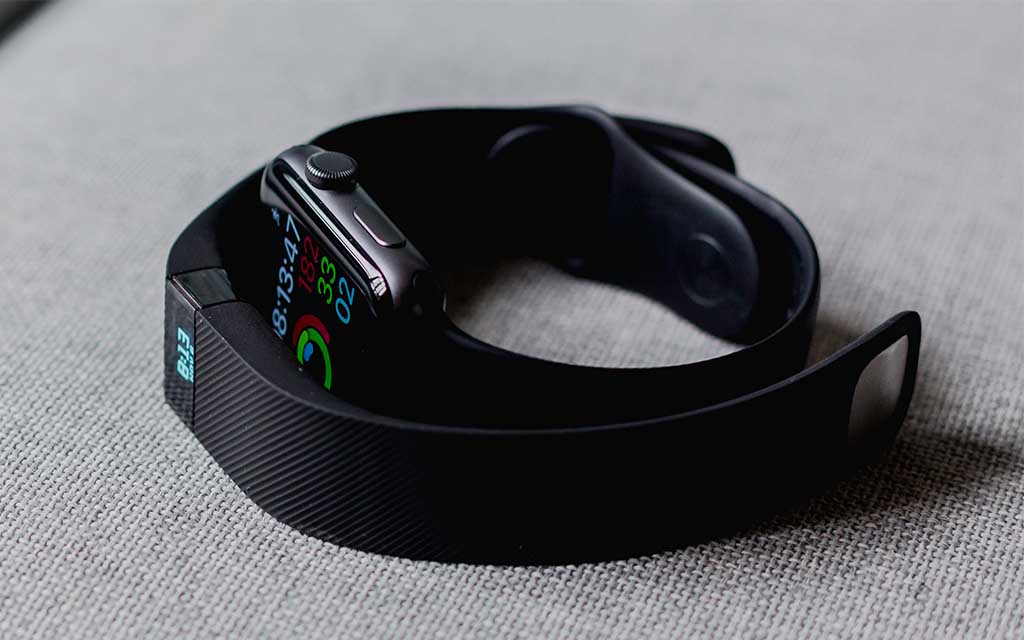Once a day, usually in that late afternoon work wasteland between lunch and dinner, the Fitbit on my wrist throws a party. It buzzes for six straight seconds, animatronic fireworks shoot across the little hard-coated plastic screen, and the number “10,000” flashes repeatedly. On certain days, especially after a motivated morning run, that celebration can arrive hours earlier. On others, it may not come until I trudge to the bathroom just before bed, after I’ve long forgotten about it. But in every instance, it fills me with a sense of satisfaction. Against all odds, I’ve done it. I’ve taken 10,000 steps.
In the mid-1960s, a a Japanese watch company called Yamasa Clock debuted the figure that has been associated with daily step-counts, activity meters and modern wearables like Fitbit and Apple Watch ever since. The young brand’s marketing team named their pedometer Manpo-kei, which translates to “10,000 steps meter.” Something about the number sounded right: it was large enough to feel like a goal, but small enough to feel like an achievable one for the average adult. But Yamasa’s motive was even less scientific than that. The Japanese character for 10,000 somewhat a resembles a gentleman out for a brisk stroll: 万.

Some 40 years later, an epidemiologist named I-Min Lee was in a friendly contest with her colleagues at the Harvard University School of Public Health to see which team could score the most overall steps per day. As the competition wore on and participants struggled to meet the daily goal of 10,000 steps, Lee did a little digging on the number and discovered the Yamasa backstory. And then, because this is Harvard we’re talking about, she used her background in exercise study to launch a full research study, relating step volume with all-cause mortality in older women.
The number 10,000 didn’t come up in her research, but the numbers 2,700 and 4,400 did. Over several years, she followed 17,000 women with a mean age of 72, and ultimately deduced that women who averaged 4,400 steps a day had lower mortality rates than those who averaged 2,700 steps a day. Her team’s research suggested that a blanket “10,000 steps or bust” approach is counterproductive; based on age, gender and lifestyle, a far smaller number can still have positive impacts on longevity. This was reinforced in another study published in March of this year, which found lower all-cause mortality for a sample size including a range of middle-aged men and women, 36% of whom were obese. Those who walked closer to 8,000 steps a day (as opposed to 4,000) were considered healthier.

Despite these findings, the 10,000 steps goal persists. Fitbit, for their part, has somewhat addressed its product’s continued commitment to the 10,000-steps concept: the number equals about five miles a day for most people, so the brand markets the distance as more than enough time to fit in the CDC’s recommendation of 30 minutes of exercise per day. It can be helpful to think of steps in terms of minutes. At the adult average walking pace of 3.5 miles per hour, traveling five miles would take up about an hour and a half throughout the day. If you were to tally up all the time you spend away from the desk and moving around during the day, would it add up to over an hour?
Perhaps. But still, what does it really all mean? As Lee and other researchers have already identified, equating some arbitrary step count with a healthy daily life doesn’t actually make it true. Too many other factors are at play in the equation: for one, not every step is created equal. In a pinch last year, I decided to rely on my Fitbit’s mileage feature during a run. I was surprised following the run to see that I was minutes off the average mile split I’d been gunning for — and I’d run well — until I realized that my little wearable was shortchanging me at least a mile. Strides get longer as we move faster, which tallies fewer steps, which equates to less mileage.
Interestingly, that system also puts brisk walkers at a disadvantage in the daily race to 10,000. Which is a bit of a shame — fast walking is one of the healthiest daily habits available to us. A study published in Mayo Clinic Proceedings in June 2019 found that people who routinely walk at least 100 steps a minute can expect to live 15-20 years longer. Not too shabby. The head researcher on the project, Dr. Francesco Zaccardi, a clinical epidemiologist at the University of Leicester in the United Kingdom, reported that longer life expectancies were evident across a massive variance of participating body mass indexes, from 20 all the way up to 40 (which is characterized as obese).
That’s because motoring down the sidewalk isn’t just a gimmicky advertisement for suburban living. Brisk walking is a legitimate form of low-intensity cardio. Performed every single day, quicker strides serve to strengthen the heart, and are likely to lessen risk of a cardiovascular disease later in life (which everyone is at risk for — CVDs, remember, account for over 30% of global deaths each year). This isn’t exactly groundbreaking stuff; there were studies on the importance of “stride rate” back in 2014. In one study, participants who reached at least 5,000 steps a day while mixing in aerobic steps (periods of walking 60 steps per minute) scored more desirable readings for body fat percentage, waist circumference and systolic blood pressure than those who reached 5,000 steps a day without any aerobic steps.
The reason why walking speed hasn’t wedged itself into brains quite like step count is because the former implies some sort of concentrated effort. One of the joys of reaching 10,000 steps is not really knowing how you got there. I’m a phone-call roamer, and sometimes I’ll hop off a call having walked well over 1,000 steps without even thinking about it. Generally, pedometers aren’t fussy; they’ll accept and log trips to the kitchen, shuffles in the shower, or that little jig you like to perform at the end of a workday. Ironically, though, there are a ton of strenuous exercises a step counter will not honor properly.
Cycling does not get its due with a wearable. It just can’t measure the movement (I’ve noticed it picks up a step or two for every five seconds of riding). That goes for any other endurance exercise on wheels, including activities like roller skating and longboarding. Swimming, obviously, is also left out in the rain. As are most forms of static strength training, or functional, lifestyle movements outside of the gym, like digging a hole or trimming the hedges in your backyard. Here, then, lies an even bigger issue with viewing 10,000 steps as a grail for personal fitness: that line of thinking devalues or even disregards other important forms of fitness that condition the body in their own unique ways. A step goal, if attained, might offer the illusion of a “healthy day.” But wellness routines thrive on challenges that shock the body, that trigger a hypoxic ventilatory response. That could mean HIIT, which will offer a load of steps. But sometimes it might mean surges on the bike, or 50 laps in the pool.
How many steps should we take a day? Even with all we now know, 10,000 isn’t a bad number. It just shouldn’t necessarily be a goal. Studies that connect step volume to longevity routinely hover in the 5,000- to 8,000-step range. I’d recommend monitoring your daily step-count routine over the course of a week. Even if you think you know it, there’s a decent chance it’s been affected one way or another by the quarantine. If you’re way below 5,000-8,000, see if there is an opportunity to get that number up. But be conscious of the kind and quality of steps you’re taking, too. Walk with purpose for portions of the day, seeking out either an increased stride rate or a steeper grade of path, in the form of hills or stairs. And remember, all the other exercises you’re doing count, too. Rocky liked running up steps, but his body was built with push-ups.
Most of all, remember to enjoy the steps you do take. Last week, The New York Times asked New Yorkers to share “the things they achingly miss” during quarantine. I long for my daily constitutional from InsideHook’s office in Midtown to the lower reaches of Central Park. The Heckscher Ballfields are down there and I like to stop and watch the midday games, which are inexplicably comprised of coeds in their mid-20s and guys who look like they taught at NYU in the ’90s. It was going to be my job this spring to find out how they all know each other. I miss scrambling over the schist, knowing the bench that gets the most sun, dodging selfies. It’s admirable to try to improve your physical conditioning each day with thousands of steps — just remember to leave a few hundred or so for the soul.
Whether you’re looking to get into shape, or just get out of a funk, The Charge has got you covered. Sign up for our new wellness newsletter today.























